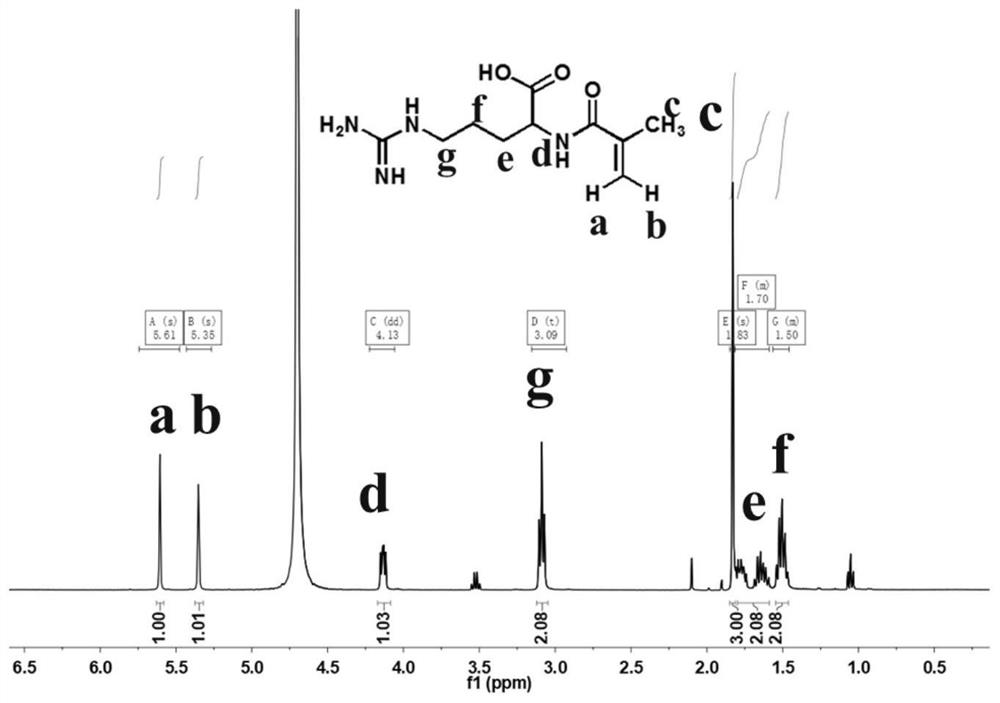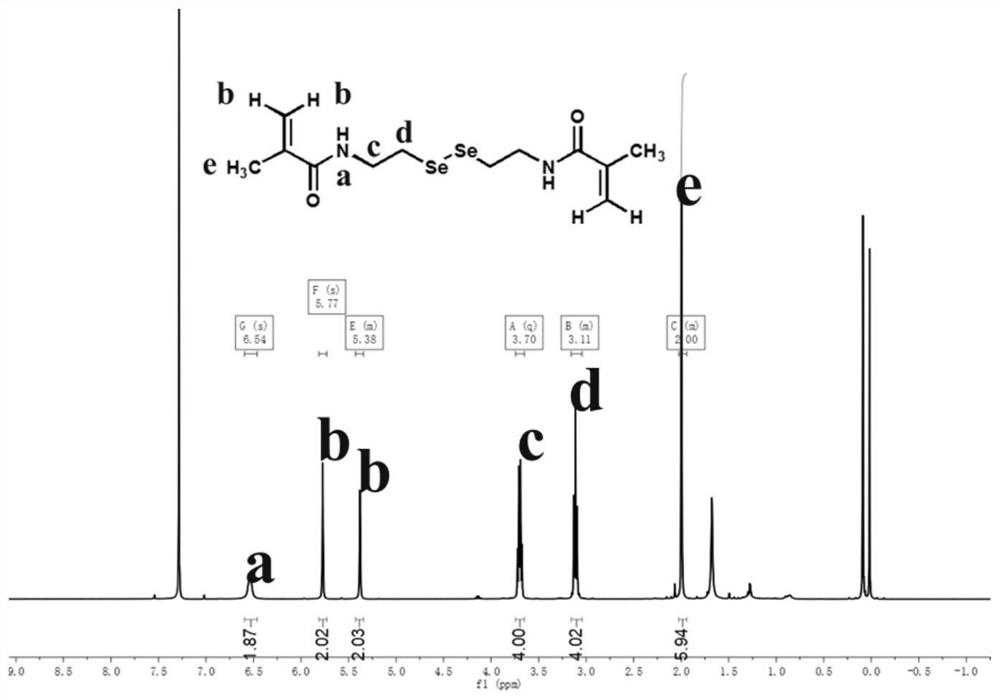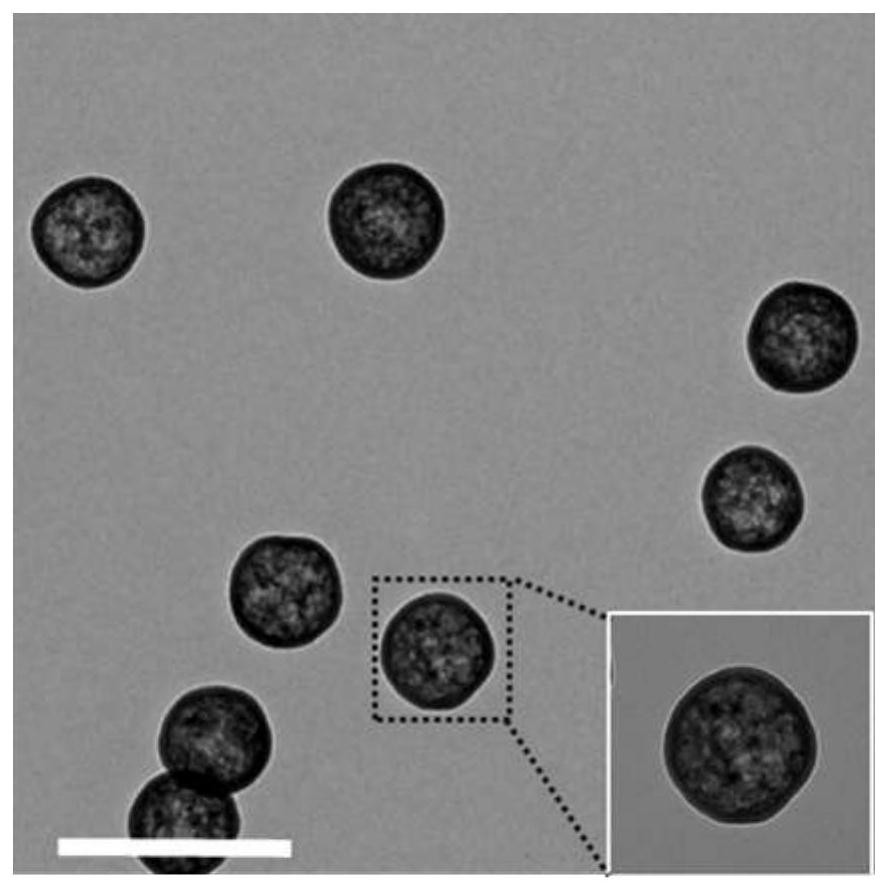A zwitterionic polymer-based nitric oxide-driven nanomotor and its preparation method and application
A zwitterion and nitric oxide technology, applied in the field of new biomedical nanomaterials, can solve problems such as load instability, shedding, and low fuel load efficiency
- Summary
- Abstract
- Description
- Claims
- Application Information
AI Technical Summary
Problems solved by technology
Method used
Image
Examples
Embodiment 1
[0053] Preparation of L-Arginine Derivatives:
[0054] (1) 11.5 mmol of L-arginine was weighed and dissolved in a mixed solvent of deionized water (20 mL) and 1,4-dioxane (8.5 mL), ultrasonically dispersed, and magnetically stirred at room temperature;
[0055] (2) 4.5 mL of triethylamine was added to the reaction system in (1), and the solution was cooled to 0°C with an ice-water bath;
[0056] (3) 18.9 mmol of methacrylic anhydride was added dropwise with stirring, then the ice-water bath was removed, and the reaction was stirred. The reaction system was 25° C. and the reaction time was 12 h.
[0057] (4) The solution obtained in step (3) was added dropwise to 400 mL of acetone for precipitation, then the precipitate was redissolved in water, and then precipitated in acetone again, and the precipitation step was repeated twice to dissolve in water.
[0058] (5) Centrifuge the solution in (4) at 8000 rpm for 15 min, discard the upper layer liquid and take out the lower layer...
Embodiment 2
[0062] Synthesis of Diselenide Compound Crosslinker with Reactive Oxygen Species (ROS) Response:
[0063] (1) Weigh 1.0 g of 2,2'-diselane diethylbis(1-ethylamine) dihydrochloride (CAS No.: 3542-13-0) and 3.6 mL of triethylamine, add to 60 mL of diethylamine In methyl chloride, the mixture was cooled to 0°C.
[0064] (2) 1.3 g of methacryloyl chloride was slowly added to the solution obtained in step (1), followed by the reaction in a nitrogen atmosphere at a reaction temperature of 25° C. and a reaction time of 24 h.
[0065] (3) Extracting the reacted solution in step (2) with a large amount of deionized water to remove impurities, and collecting the organic solvent phase.
[0066] (4) The organic phase collected in step (3) was dried with anhydrous sodium sulfate overnight to obtain a crude product, and the organic phase was removed by evaporation under reduced pressure.
[0067] (5) using the crude product obtained in step (4) as raw materials with different ratios of et...
Embodiment 3
[0071] Fabrication of NO-driven nanomotors based on zwitterionic polymers:
[0072] (1) Weigh 0.5 mmol of L-arginine derivative and 0.05 mmol of diselenine ether crosslinking agent with active oxygen response type in a three-necked flask;
[0073] (2) use vacuum pump to remove the air in the flask in step (1), and continue to feed nitrogen;
[0074] (3) adding 20 mL of dry dimethyl sulfoxide solution to step (2), and ultrasonically dispersing and dissolving;
[0075] (4) Weigh 0.03 mmol of azobisisobutyronitrile, add 500 μL of dry dimethyl sulfoxide solution, disperse and dissolve by ultrasonic, and inject the syringe into the reaction system in step (3);
[0076] (5) transfer the three-necked flask to the oil bath pot, stir magnetically at 300 rpm, the reaction temperature in a nitrogen atmosphere is 90 ° C, and the reaction time is 4 h to carry out polymerization to obtain a milky white uniformly dispersed zwitterionic nitric oxide nanomotor solution;
[0077] (6) The obta...
PUM
| Property | Measurement | Unit |
|---|---|---|
| volume | aaaaa | aaaaa |
Abstract
Description
Claims
Application Information
 Login to View More
Login to View More - R&D
- Intellectual Property
- Life Sciences
- Materials
- Tech Scout
- Unparalleled Data Quality
- Higher Quality Content
- 60% Fewer Hallucinations
Browse by: Latest US Patents, China's latest patents, Technical Efficacy Thesaurus, Application Domain, Technology Topic, Popular Technical Reports.
© 2025 PatSnap. All rights reserved.Legal|Privacy policy|Modern Slavery Act Transparency Statement|Sitemap|About US| Contact US: help@patsnap.com



